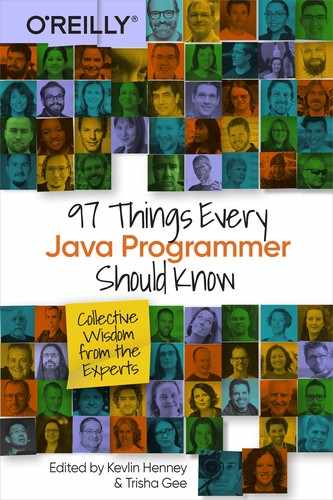Chapter 16. Declarative Expression Is the Path to Parallelism
Russel Winder

In the beginning, Java was an imperative, object-based programming language. Indeed, it still is. Over the years, though, Java has evolved, at each stage becoming more and more a language of declarative expression. Imperative is all about the code explicitly telling the computer what to do. Declarative is about the code expressing a goal abstracting over the way in which the goal is achieved. Abstraction is at the heart of programming, and so the move from imperative code to declarative code is a natural one.
At the core of declarative expression is the use of higher-order functions, functions that take functions as parameters and/or return functions. This was not an integral part of Java originally, but with Java 8 it moved front and center: Java 8 was a turning point in the evolution of Java, allowing replacement of imperative expression with declarative expression.
An example—trivial but nonetheless indicative of the main issue—is to write a function that returns a List containing the squares of the argument List to the function. Imperatively, we might write:
List<Integer> squareImperative(final List<Integer> datum) {
var result = new ArrayList<Integer>();
for (var i = 0; i < datum.size(); i++) {
result.add(i, datum.get(i) * datum.get(i));
}
return result;
}
The function creates an abstraction over some low-level code, hiding the details from the code that uses it.
With Java 8 and beyond, we can use streams and express the algorithm in a more declarative way:
List<Integer> squareDeclarative(final List<Integer> datum) {
return datum.stream()
.map(i -> i * i)
.collect(Collectors.toList());
}
This sets out at a higher level of expression of what is to be done; the details of how are left to the library implementation. Classic abstraction. True, the implementation is within a function that already abstracts and hides, but which would you rather maintain: the low-level imperative implementation or the high-level declarative implementation?
Why is this such a big deal? The above is a classic example of an embarrassingly parallel computation. The evaluation of each result depends only on one item of input; there is no coupling. So we can write:
List<Integer> squareDeclarative(final List<Integer> datum) {
return datum.parallelStream()
.map(i -> i * i)
.collect(Collectors.toList());
}
Doing so, we will get the maximum parallelism that the library is able to extract from the platform. Because we are abstracting away from the details of how, focusing only on the goal, we can turn a sequential data-parallel computation into a parallel one trivially.
It will be left as an exercise for the reader to (attempt to) write a parallel version of the imperative code should they so wish. Why? Because for data parallel problems, using Streams is the right abstraction. To do anything else is to deny the Java 8 evolution of Java.
